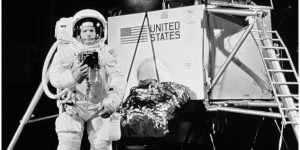What Happened On July 20th?
On July 20, 1969, Neil Armstrong became the first human to set foot on the moon. Such an achievement showcased the extraordinary capabilities of space technology and the determination of those who were involved in the Apollo program.
Reaching for the Stars
In 1961, President John F. Kennedy announced the Apollo program, aiming to land a man on the moon and return him safely before the decade’s end. This goal responded to the Soviet Union’s early space successes, including Yuri Gagarin‘s orbit of Earth, pushing the United States to advance its space capabilities.
NASA faced immense challenges, requiring major advancements in engineering, navigation, and human endurance. The Apollo program brought together the best minds and resources, leading to missions that tested and refined the technology and procedures for lunar travel.
Kennedy emphasized the task’s difficulty in his speech, stating, “We choose to go to the Moon in this decade and do the other things, not because they are easy, but because they are hard.”
Apollo 11, tasked with the first lunar landing, launched on July 16, 1969, from Kennedy Space Center in Florida. The crew included Commander Neil Armstrong, Command Module Pilot Michael Collins, and Lunar Module Pilot Edwin “Buzz” Aldrin. They traveled aboard the Saturn V rocket, standing 363 feet tall and generating 7.6 million pounds of thrust.
As Armstrong and Aldrin descended to the lunar surface in the Lunar Module, Eagle, Collins orbited above in the Command Module, Columbia. Approaching the moon, Armstrong saw that the original landing site, the Sea of Tranquility, was strewn with boulders. Displaying remarkable composure and skill, he took manual control and guided the module to a safer area.
At 20:17 UTC on July 20, 1969, the Eagle touched down on the moon. Armstrong’s first words, “Houston, Tranquility Base here. The Eagle has landed,” confirmed their successful arrival. These words highlighted the mission’s success and the culmination of extensive preparation and teamwork.
Armstrong descended the Lunar Module ladder at 02:56 UTC on July 21. As he stepped onto the moon, he declared, “That’s one small step for man, one giant leap for mankind.”
Armstrong’s step was not just a personal achievement but a triumph for thousands of scientists, engineers, and visionaries. It demonstrated what people could achieve through collaboration and dedication.
The astronauts carried a small silicon disk with goodwill messages from leaders of 73 countries, symbolizing a global message of peace and unity. This disk highlighted the mission’s broader significance, emphasizing a shared human accomplishment.

Armstrong brought a piece of the Wright brothers’ airplane, linking early aviation’s pioneering spirit with space travel. This gesture demonstrated the progression of human innovation, from the first powered flight to reaching the moon.
They left various items on the moon, including an American flag, a plaque reading, “Here men from the planet Earth first set foot upon the Moon, July 1969 A.D. We came in peace for all mankind,” and medallions honoring deceased Soviet cosmonauts and American astronauts. These artifacts remain on the moon, serving as reminders of this historic event.
The Lunar Module had only 30 seconds of fuel remaining when it touched down. Armstrong and Aldrin faced the risk of an abort if they couldn’t land within that narrow window. Their calm and precise actions under pressure were crucial to the mission’s success.
During their two and a half hours on the lunar surface, the astronauts conducted experiments and collected samples. They deployed scientific instruments, including a seismograph to measure moonquakes and a retroreflector for precise Earth-to-moon distance measurements. These experiments provided valuable data that influenced future lunar missions and expanded scientific understanding.
Over 125 million Americans alone watched the moon landing live on television, making it one of the most-watched events in history. The grainy black-and-white images broadcast from the moon engaged viewers, creating a sense of shared achievement.
The transmission of these images involved a complex process. The lunar module’s signal traveled through multiple stations on Earth before reaching viewers. This technical feat demonstrated the advancements in communication technology that paralleled the achievements in space exploration.
After their historic moonwalk, Armstrong and Aldrin rejoined Collins in the Command Module. They left the moon on July 21, 1969, and returned to Earth. The crew splashed down safely in the Pacific Ocean on July 24, 1969, where the USS Hornet recovered them.
NASA quarantined the astronauts to prevent any potential contamination from lunar pathogens. This precaution, though later deemed unnecessary, was all a part of the meticulous planning and caution characterizing the Apollo missions.
Apollo 11’s achievements inspired generations to pursue careers in science, technology, engineering, and mathematics. The mission demonstrated the heights humanity could reach when united by a common goal.
Neil Armstrong’s first step on the moon represented the potential for human exploration and the spirit of discovery that continues to drive space exploration today. Apollo 11 paved the way for subsequent missions and the ongoing quest to explore and understand our universe.
July 20, 1969, stands as a landmark in human history. Neil Armstrong’s walk on the moon showcased human ingenuity, courage, and determination. This “one small step” indeed became “one giant leap” for all of humanity, expanding our understanding of what is possible and igniting a passion for exploration and discovery.





